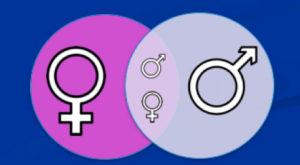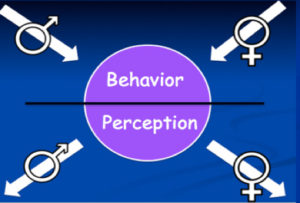Dr. Jeannette Wolfe, MD
The Basics
Basic definitions: Although biological sex and gender are often used interchangeable in the media, in scientific literature these refer to two different things.
Biological Sex: Our innate chromosomal and hormonal make up. Most of us are born XX female or XY male- though about 1 in 1500 individuals are born intersexed in which they either have an atypical number of sex chromosomes or an unanticipated hormonal glitch (either a change in the amount or reactivity of certain hormones) making them fall outside a binomial categorization.
Gender: how we self-identify to certain roles and expectations within society
Cisgender: our biological sex aligns with our gender
Transgender: our biological sex does not align with our gender
Click here for a more complete list of definitions
In medicine biological sex and gender can both influence health and sometimes in different directions. For example, in developed countries preterm males have increased morbidity and mortality compared to preterm females because testosterone (associated with biological sex) delays lung maturation. As preterm male infants have significantly higher levels of prenatal testosterone, they are at higher risk for respiratory failure. In contrast, in several developing countries infant mortality is much higher in females due to their gender . This is because in those societies females are valued less than males and often do not receive the same resources and medical care as their male peers.
Neuroplasticity– the ability of the brain to change its physical structure and neural connections throughout our lifespan.
Connectomics– an emerging new field that collectively encompasses many other fields and which is focused on better understanding the wiring of the brain. Connectomics includes the study of how microscopic information is transmitted across the gap (synapse) between two nerve cells, as well as the macroscopic communication of large bundles of nerves transmitting data across large brain regions. How big certain areas of our brain are may be less important than how and where it is most efficiently connected. To put into perspective the enormity and sheer mathematical numbers associated with this task- the human brain has about 86 billion neurons and each neuron may have as many as 10,000 synapses!
Difference between organizational versus activational hormones.
Organizational Hormones: Both men and women produce testosterone, estrogen and progesterone just in different amounts. There are two periods during our lifespan in which the relative amount of these different circulating hormones imprint permanent wiring changes in the brain – prenatal development and puberty. Essentially exposure to hormones during these critical times helps the brain create and “organize” its long-term traffic patterns.
Activational Hormones: Besides the mammoth permanent wiring changes that occur during prenatal development and puberty, our brains are also susceptible to transient changes in how we process information based on the fluctuating levels of different hormones. Think of this as being a “brain detour” in that the way we typically process information is being temporarily rerouted. Importantly, depending upon the extent of these changes, we may be consciously unaware that they are occurring.
To put this in better context, imagine that when we come into the world our brains are like architecturally styled houses. Our sex chromosomes and organizational hormones help determine what the structure of our house looks like and most of us usually end up with some version of either a ranch or a colonial. The way we furnish the rooms of our “house” however, are much more fluid and variable and based upon a bunch of factors including our genetics, preferences, experiences, opportunities and hormonal fluctuations. When our hormonal levels temporarily shift, our room décor can subtly change and importantly these changes may not even reach our conscious awareness.
For a concrete example, men are exposed to significantly larger amounts of the organizational hormone testosterone both prenatally and during puberty – this, along with the influence of their Y chromosome, establishes some permanent networking tracks in their brain that influences how they approach conflict and interpret non-verbal language. In addition, testosterone can also act as an activational hormone and its release can trigger temporary wiring modifications that can subtly alter behavior. For example, winning in a competition can significantly raise testosterone levels in some men and the elevated levels can temporarily change brain wiring such that they may now reweight (often unconsciously) risk perception leading to a decreased threshold of engaging in what was previously seen as risky behavior.
Framework of how men and women may differ
There are lots of ways to frame and answer this question, but I am particularly fond of the way that neuroscientist Margaret McCarthy and her team approaches it. They divide differences into three main categories: isolated circles, overlapping circles, and convergence/divergence circles.
 Isolated circles
Isolated circles
Here men and women get sorted into discrete circles by either having or not having a specific trait. For example, most of us can be nicely slotted into one of two circles by our biological sex: XX female or XY male. (In reality, even this simple example is more complicated as about 1 in 1500 people are born “intersexed” and cannot be easily placed in either circle due to an unexpected number of sex chromosomes or a genetic hormonal error.)
As you might imagine, most traits that reliably fall into this either/or category are related to things associated with reproductive functioning. For example, only males get prostate cancer and only females get ovarian cancer.
 Overlapping Circles
Overlapping Circles
As illustrated, this category suggests an overlap. Here although some men and some women may be different in a particular trait or behavior, other men and other women will not differ. A classic example of this is aggression. After early childhood, the use of physical aggression is much more common in men versus women. For example, according to a 2013 United Nations report, more than 95% of homicides worldwide are committed by men.
However, when we compare individual men to individual women, we may or may not find that they express aggression differently. We also now know that although some individuals may have an increased genetic predisposition to certain types of aggression, whether or not they actually display aggressive behavior is hugely influenced by their environment. For example, if you take two men with the same genetic predisposition and raise one in rural Kansas and the other in intercity Chicago as adults they will likely exhibit different levels of aggressive behavior. Interestingly, there is also some evidence that aggression in women is increasing in certain lower socioeconomic environments and is theorized to be linked to decreases – due to migration, poverty or incarceration- in the availability of desirable male partners.
Most of the things that I talk and write about on this website fall within this category of overlap and it is important to keep two things in mind. One, biological sex and/or gender are only two variables and many other things (like genetics, cultural, generational or environmental exposures) can also influence our health and behavior. And two, that in most instances biological sex and gender exists in a continuum and not discrete piles.
Interestingly, in some qualities when we look at the average differences between large groups of men and women, they are actually much smaller than the range of differences between people of the same sex.

For example, the variation of height or math testing scores between two different men (shown in blue) may be much greater than the variation between the average height or the average math score of a group of men compared to a group of women. Evolutionary psychologists suggest that this intrasexual difference may be partially explained by subtle differences in brain development that has occurred over tens of thousands of years and which was initially driven by different patterns of male reproductive strategies.
Men have what is known as a higher “reproductive variance”, which in English means that as a group men (compared to women) have a greater range in the number of children they produce. If the ultimate evolutionary game is to move DNA into the next generation, men can accomplish this by two very different strategies. They can either father and invest in a small number of children or they can play the numbers game and try to impregnate lots of different women and then gamble that some of them will have children who survive through puberty. Little skeptical? At least 16 million Asian men are estimated to have DNA directly linked to Genghis Khan!
As both of these strategies can ultimately be successful, men may have evolved to have greater variation in how their brains work.
 Convergence and Divergence
Convergence and Divergence
This category is super interesting because it challenges the assumption that just because men and women “do” or “perceive” the same thing that what is happening inside their brains is identical.
Convergence. We now know that for at least some tasks that men and women use different areas of their brain to tackle the same work. One of the classic examples of this is directions. Say a man and a woman are both meeting a group of friends at a new restaurant across town. If we could sneak inside their brains, we might observe different preferred strategies to locate the restaurant. Men typically use an Euclidean grid like orientation or a three-D mental map and likely prefer directions that sound like this:
“Go north two miles, turn west on Oak Street and then in 2 miles head east on Grandview for half a mile and the restaurant will be on the left”.
This “allocentric” type of navigation relies heavily on areas of the hippocampus and parahippocampus and may give an individual an advantage in navigating through a large open space with few visual markings.
Conversely, the woman’s preferred directions may sound more like this:
“Turn right at Oak street just before the Starbucks, in 2 miles look for a large white steeple church with a red front door and take the first left after that onto Grandview. You’ll notice the restaurant on the left in about half a mile and you’ll know that you’ve gone too far if you pass the Shell gas station on the corner.
This so called “egocentric” navigation, is accomplished by using reference points and landmarks. This strategy relies more heavily on firing in the frontal cortex and parietal lobe and may be more advantageous in quickly locating objects in a confined space.
Of note, neither of these strategies are “right” or “wrong” they are just different ways to approach the same problem. I am a firm believer that motivated and intelligent men and women can learn how to do most things effectively but it may be that how that information is presented is related to its relative ease of mastery. For example, perhaps locating a destination would be easier for some women if their GPS navigational system supplied them with building landmarks instead of street names. Conversely, in certain areas where sex based differences have been consistently found, like spatial rotation, sex differences can be mitigated by directed training programs which “teach” the brain to form new wiring pathways. Understanding that men and women may have different natural strategic pathways is an important consideration when developing programs geared to increase gender balance in science and tech fields.
Divergence. This is about how men and women may perceive the same exact stimuli or event quite differently. Neuroscientist Dr. Larry Cahill has written a lot about this in the area of emotional memory formation and he suggests that if men and women are both exposed to the same traumatic event like a car accident, that they may actually encode and remember different things about it. His work suggests that men may be more likely to remember the greater gist of something that happened while women may be more haunted by specific details of the event such as the color of the car or the clothing she was wearing. Cahill was then able to correlate these differences in memories to different patterns of brain activity in the amygdala- the area associated with attention and fear. Specifically, he found that when processing emotional events men were more likely to fire on the right side of their amygdala and women on the left.
Work like Dr Cahill’s is incredibly important because if we can identify significant differences in how men and women encode memories we may then be able to develop interventions that are better tailored to help men and women recover from traumatic events.
seX & whY Podcasts
